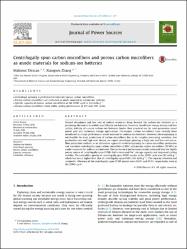| dc.contributor.author | Dirican, Mahmut | |
| dc.contributor.author | Zhang, Xiangwu | |
| dc.date.accessioned | 2020-02-05T07:42:25Z | |
| dc.date.available | 2020-02-05T07:42:25Z | |
| dc.date.issued | 2016 | en_US |
| dc.identifier.issn | 0378-7753 | |
| dc.identifier.other | 1873-2755 | |
| dc.identifier.other | 10.1016/j.jpowsour.2016.07.069 | |
| dc.identifier.uri | https://hdl.handle.net/20.500.12573/128 | |
| dc.description | This study was supported by National Science Foundation under Award Number CMMI-1231287. | en_US |
| dc.description.abstract | Natural abundance and low cost of sodium resources bring forward the sodium-ion batteries as a promising alternative to widely-used lithium-ion batteries. However, insufficient energy density and low cycling stability of current sodium-ion batteries hinder their practical use for next-generation smart power grid and stationary storage applications. Electrospun carbon microfibers have recently been introduced as a high-performance anode material for sodium-ion batteries. However, electrospinning is not feasible for mass production of carbon microfibers due to its complex processing condition, low production rate and high cost. Herein, we report centrifugal spinning, a high-rate and low-cost micro fiber production method, as an alternative approach to electrospinning for carbon microfiber production and introduce centrifugally-spun carbon microfibers (CMFs) and porous carbon microfibers (PCMFs) as anode materials for sodium-ion batteries. Electrochemical performance results indicated that the highly porous nature of centrifugally-spun PCMFs led to increased Na+ storage capacity and improved cycling stability. The reversible capacity of centrifugally-spun PCMF anodes at the 200th cycle was 242 mAh g(-1) which was much higher than that of centrifugally-spun CMFs (143 mAh g(-1)). The capacity retention and coulombic efficiency of the centrifugally-spun PCMF anodes were 89.0% and 99.9%, respectively, even at the 200th cycle. (C) 2016 Elsevier B.V. All rights reserved. | en_US |
| dc.description.sponsorship | National Science Foundation (NSF) CMMI-1231287 | en_US |
| dc.language.iso | eng | en_US |
| dc.publisher | ELSEVIER SCIENCE BV, PO BOX 211, 1000 AE AMSTERDAM, NETHERLANDS | en_US |
| dc.relation.ispartofseries | Volume: 327; | |
| dc.relation.ispartofseries | Pages: 333-339; | |
| dc.rights | info:eu-repo/semantics/openAccess | en_US |
| dc.subject | Sodium-ion battery | en_US |
| dc.subject | Centrifugal spinning | en_US |
| dc.subject | Porous carbon microfibers | en_US |
| dc.subject | Capacity retention | en_US |
| dc.subject | Coulombic efficiency | en_US |
| dc.title | Centrifugally-spun carbon microfibers and porous carbon microfibers as anode materials for sodium-ion batteries | en_US |
| dc.type | article | en_US |
| dc.contributor.department | AGÜ, Mühendislik Fakültesi, Malzeme Bilimi ve Nanoteknoloji Mühendisliği Bölümü | en_US |
| dc.contributor.institutionauthor | | |
| dc.identifier.doi | 10.1016/j.jpowsour.2016.07.069 | |
| dc.relation.publicationcategory | Makale - Uluslararası Hakemli Dergi - Kurum Öğretim Elemanı | en_US |


















